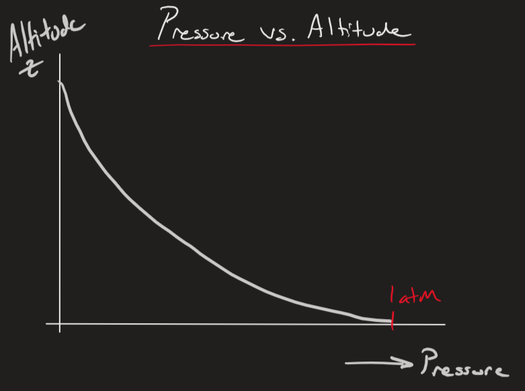L1: Introduction
Defining our Atmosphere
Looking at a graph of the Temperature vs. Altitude of our atmosphere we notice a weird temperature fluctuation going on. Here is what is going on at each layer:
- Troposphere
- Starting at ground level ambient temperature which has the highest amount of fluctuation, but once we reach 10km, the temperature decreases to -50 degrees Celsius. This is because the surface is Earth is hot, but the father away we move from it the colder it becomes.
- Stratosphere
- The ozone located in this altitude region absorbs the radiation of the sun and the temperature goes back up.
- Mesosphere
- In this region of altitude no ozone is present, so the temperature goes back down
- Ionosphere
- Here is very interesting region in which the individual atoms of oxygen present in this altitude region absorbs the radiation of the sun and the temperature goes back up.
Defining Space
When we think of defining "space" we typically think "anything past our atmosphere". This is a correct definition of space, but it is important to note that space really shouldn't be defined from the scope of Earth since space is so endless that to make everything relative to a single point makes little sense. To put things in perspective, our observable definition of space estimates that there are around 1.5 x 10^11 Galaxies present. That means that the Milky Way Galaxy only compromises less than 10^-11 of the observable galaxies. That is infinitesimally small knowing that this is only our "observable" scope of galaxies.
When we think of defining "space" we typically think "anything past our atmosphere". This is a correct definition of space, but it is important to note that space really shouldn't be defined from the scope of Earth since space is so endless that to make everything relative to a single point makes little sense. To put things in perspective, our observable definition of space estimates that there are around 1.5 x 10^11 Galaxies present. That means that the Milky Way Galaxy only compromises less than 10^-11 of the observable galaxies. That is infinitesimally small knowing that this is only our "observable" scope of galaxies.
And the Milky Way is compromised of our solar system:
Laws of Orbital Motion
The process of observing the orbits of each one of the planets and their moons have been done numerous times. But Johannes Kepler was the one who created 3 laws which govern the movement of all celestial bodies.
Kepler's Laws
The process of observing the orbits of each one of the planets and their moons have been done numerous times. But Johannes Kepler was the one who created 3 laws which govern the movement of all celestial bodies.
Kepler's Laws
- Each planet will move in an Elliptical path with the sun at one focus
- The lines connecting a planet and Sun sweeps out equal areas in equal times.
- For all planets, the orbital period squared divided by the semi major axis cubed is constant:
Laws of Gravitation
Years after Kepler, Newton would come to formulate the equation that relates the Force of Gravity enacted between two bodies.
Years after Kepler, Newton would come to formulate the equation that relates the Force of Gravity enacted between two bodies.
Standardizing the Parameters of Space Motion
Each of the following parameters are integral to describe the motion in space: Mass, Length, and Time.
Each of the following parameters are integral to describe the motion in space: Mass, Length, and Time.
- Mass:
- 1 kg. This is a standard that is kept in reference to a cube of Rubidium-Aluminum Alloy found in Paris, it will not change/decompose
- 1 kg. This is a standard that is kept in reference to a cube of Rubidium-Aluminum Alloy found in Paris, it will not change/decompose
- Length:
- Pre-1982 an object of the exact 1 meter length was kept as a reference. Problem was that it would degrade and the need for a better standard was necessary
- Post-1982 scientists used the physical constant of the speed of light in a vacuum that was not subject to change as our standard. The speed of light is defined by a constant c. Thus, 1 meter is equal to the distance light travels in 1/299,792,458 seconds.
- Time:
- We take a Cesium 133, which emits radiation is different bands. If we look at the ground state frequency of Cesium 133 (9192631770 Hz), a specific number of counted periods correlates to 1 second (9,192,631,770 periods = 1 second)





